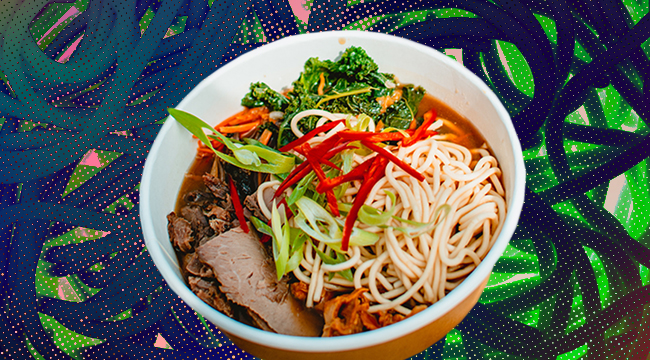The 20 Best Noodles In The World
If Amazon doesn't have a Whole Foods grocery near you, there are non-perishable groceries ( food that doesn't spoil) that Amazon can ship to you


UPROXX
“I prefer dry noodles,” chef Kasem Saengsawang tells me. “As a chef, I think a good, dry noodle has more texture and crunch when you bite into it. Also, it holds the sauce better.”
Saengsawang is chef-owner of the renowned Farmhouse Kitchen, which now has outlets in Portland, San Francisco, and Oakland. As we chatted, he prepped for Foodbeast’s Nood Beach, an all-noodle food festival being held in Huntington Beach, CA on September 1st, where he’s serving a ramen-pork-belly umami bomb dubbed “The Tornado Cup.”
Our conversation — in which Saengsawang shouts out Pad Thai as his favorite noodle dish and sings the praises of the very versatile rice noodle — underscores the fact that noodles are an integral part of global food culture. The building blocks of infinite dishes and holders of a multitude of sauces. And while there’s a massive chasm between a plate of fried chow mein in a Safeway heating tray and a bowl of bún chả on the streets of Hanoi, both can be transcendent under the right circumstances.
The 20 noodle varieties below are must-try dishes for anyone who wants to broaden their palates. We’re talking straight up noodles, though — no dumplings or mantu or tortellini. It’s also important to note, this isn’t a comprehensive list by any stretch. There are 350 noodle varieties in Italy alone with only two of those styles (three, technically) making this list. Still, if expanding your awareness of food culture is a personal goal, this primer will do the trick while taking you around the world.
If you want to get your fix closer to home, we’ve also included one of our favorite US iterations of each dish.
View this post on Instagram
THE TORNADO CUP 🌪 – Ramen noodles, eggs, slow cooked candied pork belly, Asian broccoli, and Spicy Godmother XO (Thai devil sauce made with assorted chilies, cumin, turmeric, garlic, onion, cilantro and tamarind) // This delicious dish is being served up by @thaifarmhouse, legendary Thai spot in San Francisco, Oakland, Portland and for one day only, #NoodBeach, September 1st! If you happened to be at #NoodsNoodsNoods in Oakland, you’ll know the crazy energy @popsf and his amazing team bring while the food gets cooked up. Come get noodle wasted! 😂💪🍜🌪
RAMEN — Japan
What To Talk About:
Ramen is synonymous with Japanese cuisine. However, this is a Chinese migrant dish. Chinese wheat noodles are the base of this dish and were brought over by Chinese migrants to Japan sometime between the 1600s and 1800s. Origins aside, each region of the island nation now has a version to call their own.
The real game-changer for Japanese ramen came post-WWII when Momofuku Ando changed the food world forever with “instant” ramen noodles. That fast-food revelation propelled ramen to every dorm room, office canteen, and corner shop around the world.
Where To Find It In The U.S.: Momofuku (multiple locations)
Chef David Chang’s Momofuku (yes, it’s named after Ando) is one of the best places to grab a bowl of ramen in the country. Hands down. There are eleven spots between New York, DC, Vegas, and L.A., but we’d suggest hitting the Noodle Bars in New York for this dish. It’s closer to a fast-casual/hole-in-the-wall concept that you can easily walk into without a reservation.
LAGHMAN — Central Asia
What To Talk About:
Laghman is a cornerstone dish in Central Asia between Kazakhstan, Kyrgyzstan, Uzbekistan, Uyghur and Dungan China, Tajikistan, and parts of northern Afghanistan. You can find the dish served either dry with wok-fried lamb or beef and root veg or in a thin, tomato-based soup with plenty of spice and the same ingredients as the dry version.
The noodles are a local, hand-pulled variety. Wheat is at the base with an egg, salt, and water. These aren’t eggy noodles like you find in Italy by any stretch. They’re softer in texture with a bit more gumminess. There’s a definite heft that works with the big spicy notes and fatty lamb.
Where To Find It In The U.S.: Kashkar, Brooklyn, NY
Kashkar is a Russo-Uyghur joint in Brighton Beach amongst the American-Russian community. You can try “Lagman” both ways at this spot. The hot appetizer menu has the dry version, Geiro Lagman, which uses Lagman noodles and tops them with fried meat, spices, and vegetables. Their Lagman soup has a lamb-bone broth, potatoes, lamb, spices, and tomato. Both absolutely rock.
TTEOK-BOKKI — Korea
What To Talk About:
One of our favorite expressions of the Korean oeuvre is Garae-tteok. These are long, thick, steamed rice noodles sometimes called “rice cakes” (also similar to Cantonese chow fun). The noodle is made by pounding and rolling rice flour into long tubes and then steaming them.
The resulting noodles can go through a lot of iterations. Babies often get simple fried versions on sticks. From there, the world’s your oyster when it comes to jazzing up these noodles with sauce. Enter, Tteok-Bokki. The base version fries the noodles in gochujang. Adding meats, more spice, kimchi, veg, and cheese is only the tip of the iceberg in how deep you can go from there.
Where To Find It In The U.S.: YUP DDUK LA, Los Angeles, CA
YUP DDUK LA’s signature dish is a spicy stew made with rice cakes. Their second signature dish mixes it up by adding fish cakes to the spicy rice cake stew. From there, YUP DDUK LA keeps things fresh with varying bases and toppings (melty cheese? Believe it!).

 College Dorm and Apartment Cooking gadgets - if you change the sort settings on the Amazon page, it will show other items by price
College Dorm and Apartment Cooking gadgets - if you change the sort settings on the Amazon page, it will show other items by price


















